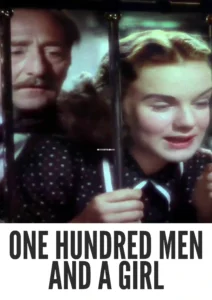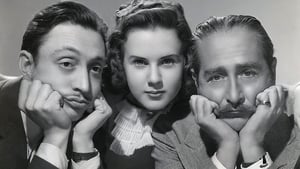Contact: info@alwanfilm.com
Video Sources 0 Views

Synopsis
Review: One Hundred Men and a Girl 1937 Colorized – A Classic Musical Triumph

Introduction
In the annals of classic cinema, few films capture the spirit of an era as delightfully as “One Hundred Men and a Girl” (1937). Directed by Henry Koster, this musical comedy stars Deanna Durbin, Adolphe Menjou, and Leopold Stokowski, blending humor, heart, and music in a story that continues to charm audiences. Notably, the film is among the early examples of Technicolor, marking a significant moment in the evolution of film aesthetics. In this article, we will explore the impact of Technicolor on the viewing experience of “One Hundred Men and a Girl” and discuss its importance in the context of film history.
Check The Full Colorized Movies List
Check Our Colorized Movies Trailer Channel
Understanding One Hundred Men and a Girl 1937 Colorized: Director, Cast, and Genre
“One Hundred Men and a Girl” emerges from the golden age of Hollywood, a period known for its musical extravaganzas and feel-good narratives. Directed by Henry Koster, a filmmaker celebrated for his light touch and comedic sensibility, the film showcases the talents of Deanna Durbin, a young actress and singer whose performances captivated Depression-era audiences.
Deanna Durbin stars as Patricia “Patsy” Cardwell, a spirited and resourceful teenager determined to help her unemployed father and his friends find work as musicians. Adolphe Menjou plays her father, John Cardwell, and the legendary conductor Leopold Stokowski makes a rare film appearance as himself. The film blends comedy, drama, and musical performance, creating a genre-defying experience that appeals to a wide audience.
Exploring the World of One Hundred Men and a Girl 1937 Colorized: Plot and Characters
At its heart, “One Hundred Men and a Girl” is a tale of perseverance, ingenuity, and the power of music to bring people together. The story begins with John Cardwell, a talented but out-of-work trombonist, struggling to make ends meet in Depression-era New York City. His daughter Patsy, undeterred by their circumstances, concocts a daring plan to form an orchestra comprised of unemployed musicians, with the hope of securing work for them all.
Patsy’s relentless optimism and clever schemes lead her to the doors of the famous conductor Leopold Stokowski. Despite numerous setbacks and misunderstandings, Patsy’s unwavering belief in her father’s talent and the potential of their orchestra ultimately wins Stokowski’s support. The film culminates in a triumphant concert performance, symbolizing the triumph of hope and determination over adversity.
The Art of Film Colorization
The process of film colorization, particularly with early Technicolor films, represents a significant advancement in cinematic history. Technicolor, a pioneering color film process, was first introduced in the 1920s and reached its peak in the 1930s and 1940s. The vibrant colors achieved through Technicolor added a new dimension to filmmaking, enhancing visual storytelling and creating a more immersive experience for audiences.
Technicolor films required meticulous planning and execution, from costume and set design to lighting and cinematography, to ensure the colors appeared vivid and natural on screen. The result was a dazzling array of hues that brought stories to life in ways previously unimaginable, transforming the cinematic landscape.
Early Colored Films: A Brief History
The journey of early colored films is a fascinating one, marked by technological innovations and artistic experimentation. The Technicolor process, developed by Herbert Kalmus and his colleagues, revolutionized the film industry by providing a reliable and aesthetically pleasing method for producing color motion pictures.
Early Technicolor films like “The Wizard of Oz” (1939) and “Gone with the Wind” (1939) demonstrated the process’s potential, captivating audiences with their stunning visual palettes. “One Hundred Men and a Girl,” released in 1937, was among the pioneering films to utilize Technicolor, showcasing its capabilities in a musical comedy setting.
One Hundred Men and a Girl and Its Early Technicolor Version
The decision to release “One Hundred Men and a Girl” in Technicolor was a bold and innovative move, enhancing the film’s appeal and elevating its visual storytelling. The vibrant colors of the Technicolor process brought the film’s musical performances to life, adding depth and richness to the visual experience.
The Technicolor version of “One Hundred Men and a Girl” captures the bustling energy of New York City, the warmth of the Cardwells’ home, and the grandeur of the concert hall with vivid clarity. The colors not only enhance the aesthetic appeal but also serve to amplify the emotional resonance of the story, drawing viewers deeper into Patsy’s world.
The Debate Over Film Colorization
As with any technological advancement, the introduction of colorization in film sparked debates within the industry and among audiences. Purists often argue that colorization can detract from the original artistic intent, altering the director’s vision and the film’s historical authenticity. Conversely, proponents of colorization contend that it revitalizes classic films, making them more accessible and appealing to modern audiences.
In the case of “One Hundred Men and a Girl,” the use of Technicolor was integral to the film’s production and reception. Rather than an afterthought, color was a carefully considered element of the film’s design, contributing to its charm and success. The debate over colorization continues today, reflecting broader tensions between preservation and innovation in the cinematic arts.
Examining One Hundred Men and a Girl as an Early Technicolor Film
Viewing “One Hundred Men and a Girl” as an early Technicolor film offers a unique perspective on its place in cinematic history. The film’s use of color not only enhances its visual appeal but also underscores its thematic elements, highlighting the contrasts between hope and despair, struggle and triumph.
Technicolor allows for a richer depiction of Patsy’s vibrant personality and the lively world she inhabits. The bright, cheerful colors reflect her indomitable spirit and the joy that music brings to her life and the lives of those around her. The film’s color palette also underscores the emotional highs and lows of the story, from the warm, inviting tones of the Cardwells’ home to the somber, muted hues of their struggles.
Influence and Legacy: One Hundred Men and a Girl 1937 Colorized’s Impact on Cinema
“One Hundred Men and a Girl” has left a lasting impact on the cinematic landscape, influencing both the musical genre and the use of color in film. The film’s success helped solidify Deanna Durbin’s status as a major star of the era, paving the way for her subsequent career in Hollywood.
The film also demonstrated the potential of Technicolor in enhancing musical performances, setting a precedent for future musical films. The integration of color, music, and storytelling in “One Hundred Men and a Girl” inspired subsequent productions, contributing to the evolution of the musical genre in the years that followed.
Director’s Cinematic Legacy: Beyond One Hundred Men and a Girl 1937 Colorized
Henry Koster’s directorial legacy extends far beyond “One Hundred Men and a Girl,” encompassing a diverse array of films that showcase his versatility and skill. Known for his ability to blend humor, drama, and music, Koster’s work spans multiple genres and decades, reflecting his enduring influence on Hollywood cinema.
From his early comedies and musicals to later dramas and romances, Koster’s films consistently exhibit a keen understanding of character and storytelling. His ability to elicit memorable performances from his actors, coupled with his eye for visual composition, cemented his reputation as one of Hollywood’s most reliable and talented directors.
Themes Explored in One Hundred Men and a Girl 1937 Colorized
“One Hundred Men and a Girl” explores themes of perseverance, ingenuity, and the transformative power of music. Patsy’s unwavering determination to help her father and his fellow musicians reflects broader themes of hope and resilience in the face of adversity.
The film also highlights the importance of community and collaboration, as Patsy’s efforts bring together a diverse group of musicians, each with their own struggles and dreams. Through their collective efforts, they find not only employment but also a renewed sense of purpose and camaraderie.
Reception and Controversy Surrounding One Hundred Men and a Girl 1937 Colorized
Upon its release, “One Hundred Men and a Girl” received widespread acclaim from critics and audiences alike, praised for its heartwarming story, engaging performances, and innovative use of Technicolor. Deanna Durbin’s portrayal of Patsy was particularly lauded, showcasing her talent and charisma.
Despite its success, the film also faced some controversy, particularly regarding its depiction of the music industry and the realities of Depression-era America. Some critics argued that the film’s optimistic tone and comedic elements downplayed the harshness of the era’s economic struggles. However, for many viewers, the film’s uplifting message and musical performances provided a much-needed respite from the hardships of the time.
Where to Watch One Hundred Men and a Girl 1937 Colorized Online
For those eager to experience the timeless charm of “One Hundred Men and a Girl,” the film is available on various streaming platforms, ensuring accessibility to audiences worldwide. Whether in its original Technicolor format or digitally restored versions, Koster’s classic remains a must-watch for fans of musical comedies and classic cinema.
FAQs About One Hundred Men and a Girl 1937 Colorized
Common queries surrounding “One Hundred Men and a Girl” often pertain to its historical context, thematic elements, and the significance of its Technicolor presentation. By addressing these frequently asked questions, viewers can gain a deeper appreciation of the film’s enduring appeal and cultural significance.
Q: How did “One Hundred Men and a Girl” utilize Technicolor?
A: “One Hundred Men and a Girl” was one of the early films to utilize Technicolor, a process that added vibrant colors to the black and white film stock. The use of Technicolor enhanced the visual appeal of the film, highlighting the energy and spirit of its musical performances.
Q: What impact did Deanna Durbin have on the film’s success?
A: Deanna Durbin’s performance as Patsy was instrumental to the film’s success. Her natural charisma, singing talent, and relatable portrayal of a determined teenager endeared her to audiences, solidifying her status as a major star of the era.
Q: What themes does the film explore?
A: “One Hundred Men and a Girl” explores themes of perseverance, hope, community, and the transformative power of music. The film highlights the importance of ingenuity and collaboration in overcoming adversity, offering a heartwarming message of resilience and optimism.
Conclusion
In conclusion, “One Hundred Men and a Girl” stands as a shining example of early Technicolor filmmaking, its vibrant colors and heartwarming story captivating audiences for generations. While the film’s use of Technicolor enhances its visual appeal, its true power lies in its timeless themes of hope, resilience, and the unifying power of music. As we continue to explore the evolving landscape of cinema, let us celebrate the enduring legacy of “One Hundred Men and a Girl” and the innovative spirit that brought it to life.











